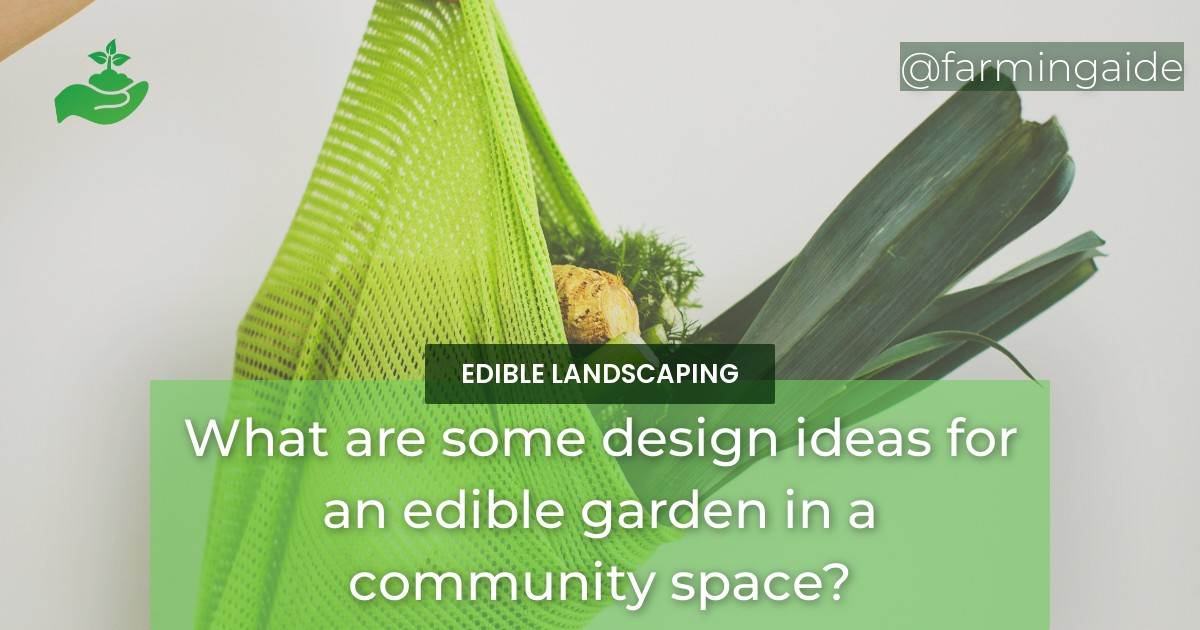Designing an edible garden in a community space is a great way to bring people together and foster a sense of community. Whether it’s a small communal garden or a larger community garden, there are many design ideas that can be used to maximize the space and make it both functional and attractive. In this article, we will explore some of the best design ideas for an edible garden in a community space.
Allotment-Style Plots
Allotment-style plots are a popular choice for community gardens. These plots are typically raised beds that are organized in a grid pattern. The beds can be any size, but are usually around 4 feet wide by 10 feet long. This allows for easy access to all parts of the bed without having to step on the soil. Raised beds are a great option because they provide good drainage and can be filled with high-quality soil. They also make it easy to control the soil’s pH and nutrient levels, which is important for growing healthy plants.
Container gardening is another option for community gardens. This is a great option for areas where space is limited or for gardeners who have mobility issues. Containers can be placed on the ground, on tables, or hung from walls or fences. A wide variety of plants can be grown in containers, including herbs, vegetables, and fruit trees. Vertical gardening is a space-saving technique that can be used in combination with containers or raised beds. Vertical gardens can be created using trellises, walls, or even old pallets.
Shared Herb and Fruit Gardens
Shared herb and fruit gardens are another popular option for community gardens. These gardens are usually located in a central area and are open to all gardeners to use and enjoy. One popular design idea for herb gardens is the herb spiral. An herb spiral is a raised bed in the shape of a spiral that is filled with different types of herbs. The spiral design allows for a variety of herbs to be grown in a small space, and the raised bed makes it easy to access the herbs.
Espaliered fruit trees are another great option for community gardens. Espaliered trees are trained to grow flat against a wall or fence, which makes them a great option for small gardens. This technique also makes it easy to harvest the fruit, as the branches are at a convenient height. Berry bushes are another great option for community gardens. Some popular types of berry bushes include blueberries, raspberries, and strawberries.
ALSO READ
Gathering and Seating Areas
Gathering and seating areas are an important part of any community garden. These areas provide a place for gardeners to socialize and rest. Picnic tables are a great option for larger gardens, while benches are a good choice for smaller gardens. Fire pits are another option for community gardens, especially those located in cooler climates. Fire pits provide warmth and a place to gather, even on chilly evenings.
Educational Signage
Educational signage is a great way to teach gardeners about the different plants and techniques used in the garden. Plant labels can be placed next to each plant, providing information about its name, growing conditions, and harvesting tips. Informational boards can be placed in strategic locations throughout the garden, providing information about the history of the garden, the different plants grown, and the community organizations involved in the project. Workshops and classes can also be offered to gardeners and community members, teaching them about different aspects of gardening, such as composting, soil health, and pest control.
ALSO READ
Composting and Soil Health
Composting and soil health are important aspects of any community garden. Composting bins can be set up in a central location, allowing gardeners to easily compost their kitchen scraps and garden waste. Vermicomposting is another option for community gardens. This involves using worms to break down organic matter, which produces a nutrient-rich soil amendment.
Cover crops are another technique used to improve soil health. Cover crops are planted in between vegetable crops, providing a living mulch that helps to prevent erosion, suppress weeds, and add organic matter to the soil. Some popular cover crops include clover, rye, and buckwheat.
Water Conservation
Water conservation is an important aspect of community gardening, especially in areas with limited water resources. Drip irrigation is an efficient way to water plants, as it delivers water directly to the roots of the plants, reducing water waste. Rain barrels can be used to collect rainwater, which can then be used to water the garden during dry periods. Mulching is another technique used to conserve water. Mulch helps to retain moisture in the soil, reducing the amount of water needed to keep plants healthy.
How Can Edible Garden Design Ideas Be Adapted for a Community Space?
Community spaces can benefit from incorporating edible garden ideas for every space. Raised beds and vertical gardens can maximize limited space. Composting and rainwater harvesting can promote sustainability. Incorporating educational programs and communal maintenance can encourage community involvement. Overall, edible garden design can enhance a community space in various ways.
Pest Control
Pest control is an important aspect of community gardening, as pests can quickly destroy a garden. Companion planting is a technique used to deter pests by planting certain plants next to each other. For example, planting marigolds next to tomatoes can help to deter aphids. Beneficial insects, such as ladybugs and lacewings, can also be introduced to the garden to help control pests. Natural sprays, such as garlic spray and neem oil, can also be used to control pests.
Designing an edible garden in a community space can be a fun and rewarding project. By incorporating some of these design ideas, you can create a beautiful and productive garden that will provide fresh food for the community and foster a sense of community spirit.
RELATED ARTICLES:


